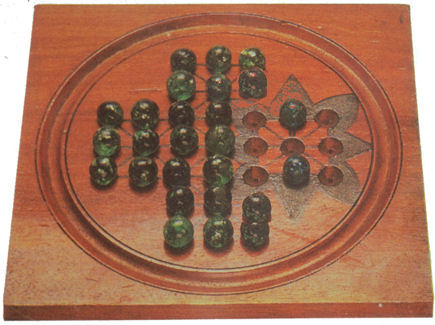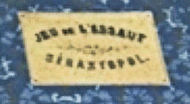
According to Parlett (Oxford History of Board Games, 1999, pages 190-192) Asalto games are just enlarged Fox & Geese games with modified or larger boards, and additional playing pieces including two foxes. He indicates that this trend started in Germany in the late 18th century with an inclusion of a military theme. He states that he doesn't know why the Spanish word "Asalto" (which translates into English as "assault") was used as the generic name for these games.
The early game boards like this one donated to the Museum in 1972 (photograph above), lookes like a Fox and Geese board, but one end of the board has an additional design element known as "The Fort". Nine of the holes on one side of an Asalto board was decorated in some fashion to indicate "The Fort" - as in this example a star design surrounds the nine holes. While this 30cm X 30cm hardwood board was machine made, earlier boards such as this were hand made. Earlier boards made use of pegs as playing pieces, this board was designed to use marbles as playing pieces. Note the circular trough around the playing surface. This trough is used to hold "captured" pieces. Some of these games were also called "Siege Games", and instructions with them explained how the game was played. Here are the "Siege" instructions provided by World Wide Games, Delaware, Ohio, U.S.
Two "guards" occupy the fort. The twenty-four "attackers" attempt to take the fort from them by occupying the nine points of the fort.
Start: The first move is made by the attackers, who must move their center piece between the guards. A guard then moves. After the next attacker moves, a guard can usually jump and capture an attacker.
Moves by Attackers: Attackers may move only FORWARD toward the fort. They cannot jump. They may move up or along any diagonal line to the fort and across the outside edge of the fort. Within the fort they may not move across the back two lines.
Moves by Guards: Guards may move forward, backward, sideways, or diagonally along any line, and in addition may jump over any attacker when there is an vacant hole beyond the attacker. When a guard jumps over an attacker to a vacant hole, the attacker is "captured", and is removed from the game and placed in the trough. Guards MUST jump out of the fort when an opening makes it possible. A guard may "capture" more than one attacker on a move, when the number of vacant holes makes this possible.
Ending The Game: The game ends when the attackers occupy the nine places in the fort, or when the guards have captured fifteen attackers.

The photograph on the right is the label on the top of a game box lid which holds a 19th century commercial Asalto game titled: JEU DE L'ASSAUT DE SEBASTOPOL, or The Siege of Sebastopol. This battle was one that excited much public interest at the time, since in a addition to a game, it generated a poem that begins "Into the valley of death rode the six hundred...", and the large orchestral overture "The Charge Of The Light Brigade". In addition the book Sebastopol Sketches by Leo Tolstoy detailed the siege in a mixture of reportage and short fiction. Click on the label to be taken to another Webpage to view information and the gameboard for this game.
The photograph of the box top on the right is another early 20th century Asalto game, this one commemorating the Boer War and the Siege of Ladysmith. The game is named Transvaal, and commemorates a battle fought by Great Britain and the two Boer Republics between 1899 and 1902. At the time one of the South African Republics was the Transvaal, and the other was the Orange Free State. Click on the label to be taken to another Webpage to view information and the gameboard for this game.
Last update March 2, 2010